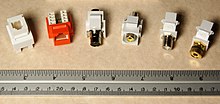Keystone module
Keystone Module is a modular connection system for standardized connectors for electrical or optical signal transmission, which is used in network installations, laboratories, workshops or in the home entertainment sector . In contrast to conventional patch panels , the passive components (connectors) are available separately from the chassis and are not permanently installed together.
Although the chassis are offered in many different variations, some with complex cable management or simply as a front panel, they all have in common that they have rectangular openings (ports or bays) measuring 14.5 × 16 mm. The keystone modules can then be locked into these. In most cases, no tools are required for this or for dismantling.
In general, it can be said that a keystone module is offered for almost every plug connection that can be mapped in a 14.5 × 16 mm grid. The most widespread are RJ45 connectors, with all common categories being represented, with or without a dust cover, waterproof or even with increased transmission capacity for PoE . In addition, there are also double couplings in order to be able to patch a plug connection from both sides. This is useful when it is necessary to integrate an active component whose network ports are brought out on the rear. The specialist trade also offers coaxial plugs such as BNC , F plugs and antenna plugs , RJ-11 and loudspeaker connectors (cinch, jack, screw / clamp connector ) as well as USB , TOSLINK , PS2 and HDMI . In addition, dummy plugs are available for unused ports.
The Keystone concept is particularly suitable for heterogeneous cabling that is supposed to bring many different signal transmissions neatly to a patch panel, as can be found in the wiring of modern residential buildings (LAN, telephony, cable TV, etc.) It also offers many advantages during assembly: cables that have been laid at a later date can easily be integrated by first connecting the new cable to the keystone module outside the network cabinet (good lighting and working conditions). This is then woven into the wiring harness and locked into the patch panel. This avoids having to loosen the patch panel, which can weigh up to 10 kg with 48 ports and fully occupied, and lift it out of the cabinet. In case of doubt, this can even save downtime. The soiling of the rack cabinet by cable sections is also prevented. Ultimately, in contrast to keystone modules, with conventional patch panels it is not possible to replace individual damaged ports.
A relevant disadvantage of keystone modules is the approx. 30% higher price per line for identical installations. In return, money can be saved by purchasing only as many modules as there are lines to be installed. Conventional patch panels are only available in 12, 24 and 48 ports.
Keystone is a standard that is used by numerous manufacturers. The processing quality and the equipment features are subject to a wide variability, and accordingly the prices. Nevertheless, keystone modules and chassis from all manufacturers can basically be freely combined with one another.
The conformity of modules and chassis is defined in US patent US 5624274 dated November 7, 1995.

